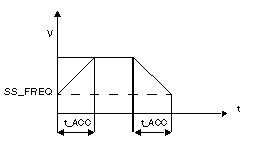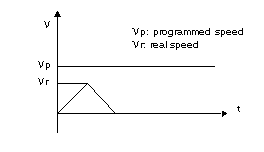|
Characteristics and performance
|
|
|
(Original Document)
|
|
Bit memory
|
Data zone
|
Program zone
|
|
|---|---|---|---|
|
TSX CFY 11
|
29
|
390
|
170
|
|
TSX CFY 21
|
58
|
780
|
220
|
|
Additional cost of first configured channel
|
0
|
0
|
2290
|
|
Function description
|
Execution time
|
|---|---|
|
Acquisition of inputs/outputs from TSX CFY
|
95 micro-seconds
|
|
SMOVE function
|
840 micro-seconds
|
|
READ_STATUS
|
540 micro-seconds
|
|
READ_PARAM
|
460 micro-seconds
|
|
WRITE_PARAM
|
760 micro-seconds
|
|
SAVE_PARAM
|
500 micro-seconds
|
|
RESTORE_PARAM
|
780 micro-seconds
|
|
Recognition of an adjustment (following a WRITE_PARAM instruction)
|
60 ms for the TSX CFY 11
210 ms for the TSX CFY 21
|
|
Recognition of the reconfiguration of a channel
|
1.5 s
|
|
If the distance to run is X0 to X1
|
Then
|
|---|---|
|
is sufficient to reach the specified speed V
|
the movement is executed according to a trapezoidal trajectory. This trajectory reveals the acceleration and deceleration periods equal to t_ACC
 |
|
is insufficient to reach the specified speed V
|
the movement is executed according to a triangular trajectory, the periods of the acceleration and deceleration phases are reduced in proportion to the speed.
 |